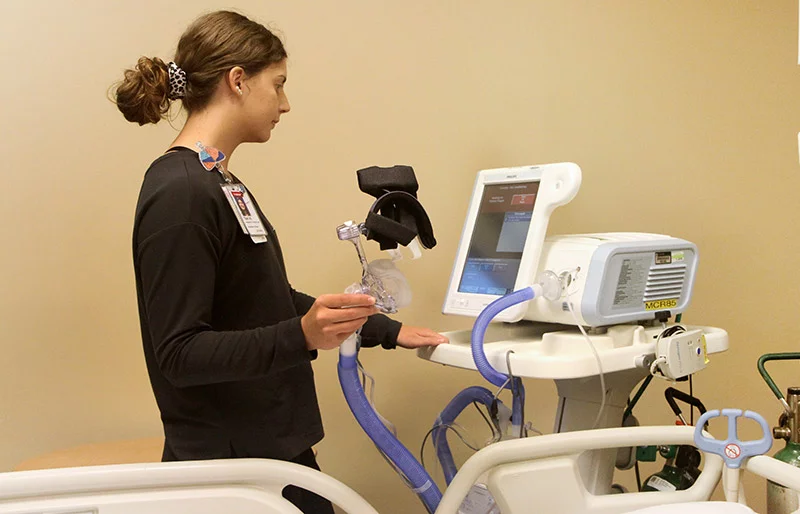
It’s a scene that plays out daily in emergency rooms and intensive care units across the country. A critically ill patient arrives. Before inserting a breathing tube, clinicians provide oxygen to reduce the risk of dangerous drops in blood oxygen levels during the procedure. This step is critical, but does the method of delivering that oxygen affect patient outcomes?
The answer is yes, according to a Department of Defense-funded study, co-led by the University of Colorado and published a little over a year ago in the New England Journal of Medicine. The multisite, randomized controlled study, dubbed PREOXI, involved 1,301 patients at 24 ERs and ICUs around the United States – including UCHealth University of Colorado Hospital.
The conclusion: patients who received their oxygen before intubation through “noninvasive ventilation” – a bilevel positive airway pressure (BiPAP) machine – were significantly less likely to suffer hypoxemia (low oxygen levels) and cardiac arrest than those who received oxygen through a mask.
The study’s final numbers told a powerful story. The patients who received oxygen through a mask before intubation were twice as likely to experience hypoxemia as the group ventilated by a BiPAP machine (18.5% vs. 9.1%). Seven patients (1.1%) in the oxygen mask group had cardiac arrest, compared with just one (0.2%) in the BiPAP group.
The case for BiPAP: Patient safety
The evidence from the study could provide a strong boost for patient safety. As the authors wrote, “These findings have important clinical implications because hypoxemia during intubation is associated with cardiac arrest and death.”

“The results were quite compelling,” said Dr. Adit Ginde, a UCHealth emergency medicine specialist. Ginde is also professor, vice chair and interim senior associate dean in the Department of Emergency Medicine at the University of Colorado School of Medicine on the Anschutz Medical Campus.
Ginde served as co-senior principal investigator for the PREOXI trial and was the co-senior author of the published paper.
“Many patients with hypoxemia still survive, but even two or three minutes can cause additional injury to their vital organs,” he said. “And their organs are already typically under threat from their medical or traumatic illness.”
Ginde is also a member of the executive committee of the Pragmatic Critical Care Research Group, a network of academic institutions that conducted the PREOXI trial. The group’s clinical trials in emergency settings aim to gather evidence that support the best and safest treatments for patients.
Finding ways to spread the positive message about BiPAP
Ginde called the PREOXI trial and its findings “practice-changing work.” But the work also leads to a follow-up question and challenge: figuring out how to accomplish that change across a broad landscape of ERs and ICUs, including those in the 12 hospitals of the UCHealth system and beyond.
It’s not enough to make the case for change simply by pointing to the clinical trial results of the PREOXI trial and expecting hospitals with different layouts and workflows in their ERs and ICUs to adopt BiPAP before intubation, Ginde said.
“It’s a heavy lift to take positive research findings and effectively implement them into clinical practice,” he said.

Doing so is a multifaceted challenge, said Dr. Neil Aggarwal, associate professor of Medicine-Pulmonary Sciences and Critical Care and director of critical care research at the University of Colorado School of Medicine. Aggarwal was the Medical ICU site investigator and publication co-author for the PREOXI trial at UCHealth University of Colorado Hospital and is a member of a team working to address the barriers to using BiPAP before intubation.
“We must convince others that the results of the study are real and that they apply to their patients and practices,” Aggarwal said. “Understanding the barriers to implementing a study into practice is key. Even the best studies that happen, if they don’t get implemented, it’s almost like they didn’t get done.”
The importance of standardizing care
The groundwork for identifying these barriers and addressing them is a painstaking task, said Dr. Jason Brainard, associate professor of Anesthesiology and medical director of surgical critical care for UCHealth University of Colorado Hospital. Brainard was the Surgical Trauma ICU and Cardiothoracic ICU site investigator for the PREOXI trial.

Brainard noted several essential steps in implementing BiPAP before intubation:
- Updating the order set for mechanical ventilation to include BiPAP for oxygenation before intubation
- Making BiPAP equipment immediately available for use in intubation
- Engaging respiratory therapists, who play an essential role in patients receiving oxygen before intubation, in discussions about implementing BIPAP before intubation
- Enlisting other key stakeholders, including ICU medical directors, nurse managers and nurse educators, to disseminate information about implementing BiPAP and its clinical benefits for patients.
The challenges and the priorities for meeting these objectives will differ among hospitals, Brainard said. However, if a hospital accepts the premise that BiPAP improves outcomes for critically ill patients, leaders need to develop a standardized procedure to ensure that it is available, he said.
“There is really only a matter of minutes before we want to implement BiPAP prior to intubation,” Brainard said. “It’s very different than other applications in clinical care where you have 30 minutes to an hour to implement a treatment. This one, to be effective, needs to be almost immediately available in real-time.”
One example of a barrier to implementing BiPAP
However, that need for speed provides just one example of the many details that could make it difficult for some hospitals to implement BiPAP before intubation, Aggarwal said. A mask delivers oxygen through tubing in the wall, making it a quick go-to when a patient struggles to breathe.
By contrast, BiPAP generally requires a separate machine to gently assist a patient with breathing in and out. The problem: someone has to get the equipment while precious seconds tick away.
“You’re bringing in a separate machine, so that’s one barrier,” Aggarwal said. He noted a timesaving alternative: a software adaptation that allows a ventilator tube – the same one used when the breathing tube goes in – to attach directly to the BiPAP mask, eliminating the need for a separate machine.
“The more places that have that type of software adaptation, the more likely it is that you will use BiPAP, because now you’re not bringing extra equipment in,” Aggarwal said. He acknowledged, however, that many ERs and ICUs do not have the adaptation as a “standard feature.” That makes the equipment issue “very likely a barrier” to adopting BiPAP.
The need to standardize and achieve consistency in oxygen use
A standardized procedure note, embedded in the electronic record, is one way to establish consistent patient care with BiPAP, Brainard said. The work, still underway for the UCHealth system, would give all ER and ICU providers a template for entering details of the procedure, including the selection of either the oxygen mask or BiPAP before intubation.
That uniform option would help hospitals in two ways, Brainard said. First, leaders could audit providers’ use of BiPAP, analyze the barriers to using it, and identify opportunities for education about the equipment. Second, hospitals could analyze other information from the procedures – medications used and complications that occurred, for example – to develop quality-improvement and patient safety projects.
“In a perfect world, these items would be included, standardly and consistently, for intubation and all other bedside procedures,” Brainard said. “We are working towards that.”
Aggarwal acknowledged that making BiPAP the standard of care for delivering oxygen before intubation is among a long list of priorities for the UCHealth system. But he said he and his critical-care colleagues remain committed to fulfilling the PREOXI trial’s promise to improve patient safety.
“I think the key thing is that everyone is motivated on some level to doing that,” Aggarwal said. “If we don’t move the needle on the device usage, the trial results definitely have less impact for our patient population.”
